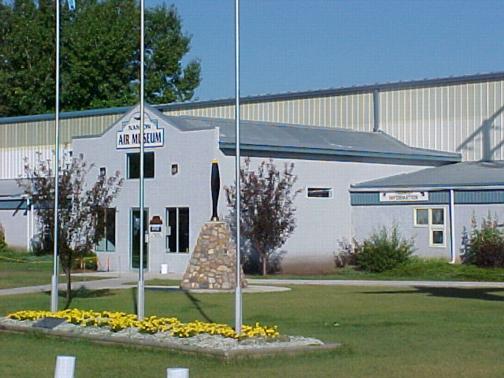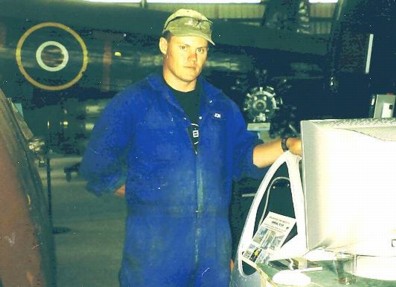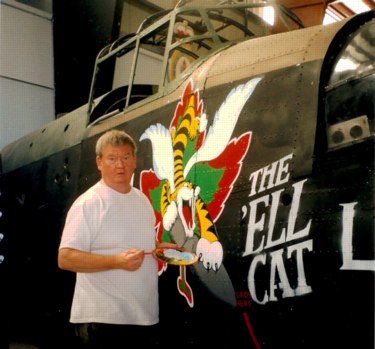 Museum
Museum  |
Bomber Command
|
Aircrew Chronicles
|
Aircrew Losses
|
Nose Art
|
BCATP
|
Lancaster
|
Media
|
Bomber Command
|
Aircrew Chronicles
|
Aircrew Losses
|
Nose Art
|
BCATP
|
Lancaster
|
Media
 Museum
Museum  |
Bomber Command
|
Aircrew Chronicles
|
Aircrew Losses
|
Nose Art
|
BCATP
|
Lancaster
|
Media
|
Bomber Command
|
Aircrew Chronicles
|
Aircrew Losses
|
Nose Art
|
BCATP
|
Lancaster
|
Media
Bomber Command Museum Archived Newsletters
On Saturday, October 26, a ceremony was held at the Mewata Armories in Calgary, where Nanton residents, Joe English and Sid Duthie, along with other WWII veterans received a "Thank You Canada" medal. This medal was given in recognition to Canadians who were involved in the liberation of Holland in 1945. Dutch Consul, Irene Bakker, presented the medals on behalf of the people of Holland. Medal recipient, ex-Lancaster pilot, Joe English, participated in the last "bombing" operation of WWII which was dubbed "Operation Manna." this entailed the dropping of food to the starving Dutch people as the war was ending. When notified that he was to receive the medal, Joe English's reaction was, "I was really surprised - I'm actually picking up the medal for my crew." the other medal recipient, Sid Duthie, a long-time NLS member and volunteer was with the Canadian army when Holland was liberated from the Nazis. The Society extends congratulations to Joe English and Sid Duthie upon their receiving this honour! |
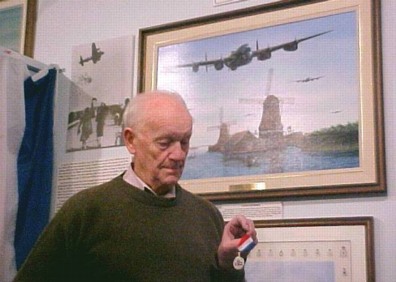 |
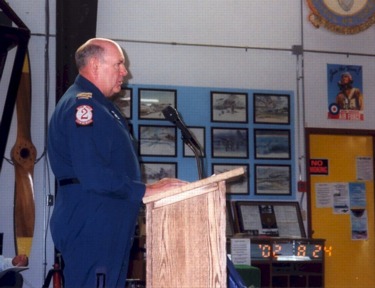 Capt. Ray hansford tells of his air force experiences and about the Canadian Forces new Harvard II primary training aircraft. Ray has served with the RCAF, RAF, and RNZAF and has many hours instructing in a variety of military aircraft. |
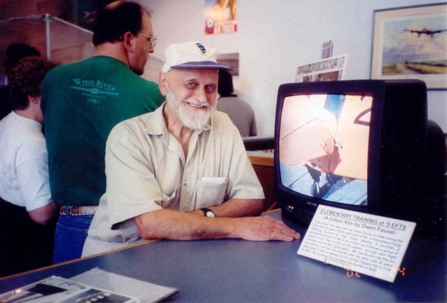 Owen Fauvel, former WWII instructor at #5 EFTS, stands beside a TV monitor in the museum. Showing on the monitor is a scene from the wartime movie film (now converted to video) he made in 1944 of the operations at #5 EFTS. |
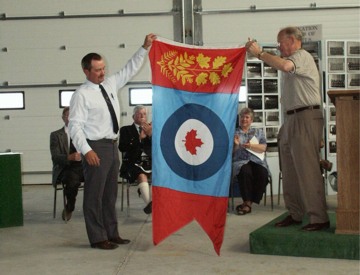 Al Lyon, director of the Alberta Aviation Museums Association, Edmonton, presents a banner from the Dept. of Veterans Affairs, Government of Canada, to Dan Fox. This is to be shared by all the Alberta aviation museums. Al took the banner back afterwards to officially present it to eath of these museums, situated at Calgary, Wetaskiwin, and Edmonton. The NLS will get to display it at a later date. |
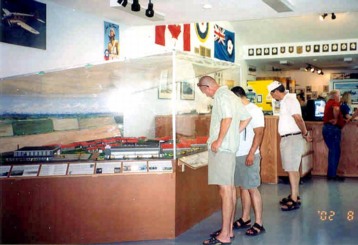 Visitors attending the August 24 event examine the model of #5 EFTS after it had been unveiled by members of Jock Palmer's family. |
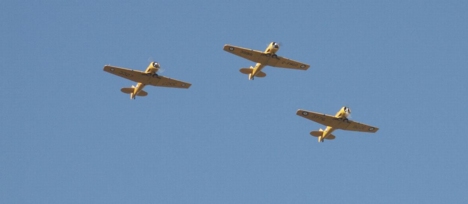
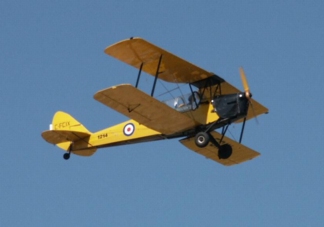 |
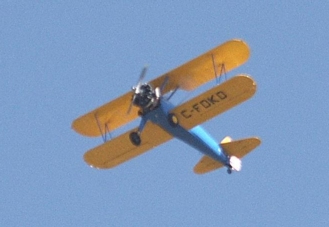 |
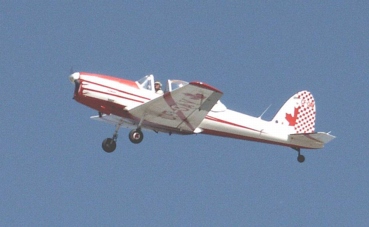 |
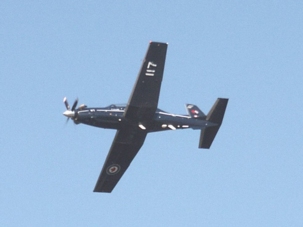 |
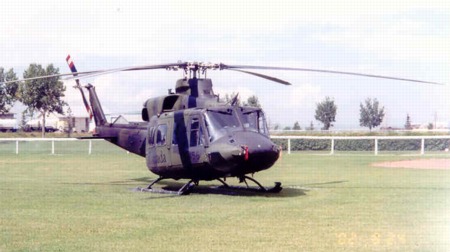
Cadets and their leaders from the Elk Valley Cadet Squadron travelled to Nanton to help with the Society's Fall cleanup day. This group has been here several times before, for both spring and fall cleanups at the museum. Clean-up this time was not in the museum but at the storage yard on curator Bob Evans' acreage. Assisting the cadets were a number of local Society members. Much progress was made in clearing the area. A large dumpster was filled with unusable materials while another trailer was filled with scrap metal. Another such cleanup will be organized for next year. The Society extends a GRATEFUL THANKS to the Elk Valley Cadets and to Ron Mueller, Champion Alberta, who generously donated the use of his enclosed trailer for transporting scrap aluminum. Ron took the load to Calgary, sold the metal, and gave the proceeds to NLS. THANKS also to Aldo Raffin for using his large front-end loader tractor to compact the materials in the dumpster so that a tarp could be installed. |
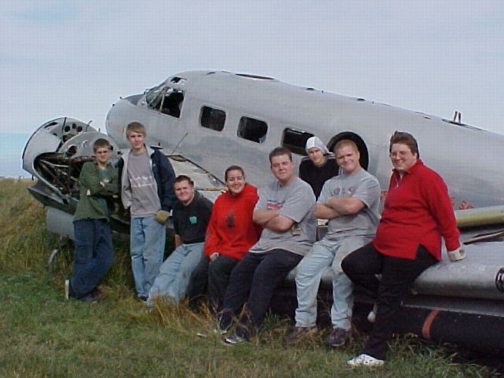
|
It is now two years since I became, first part-time, now full-time Manager of the museum. Wow, how time flies! I am kept very busy doing all aspects of keeping the museum running smoothly for the directors, volunteers and visitors. It is a challenge trying to keep on top of all the paper work involved, with accounting, collections and administrative work. However, I still have to say that this is the most rewarding and enjoyable position I have ever had the privilege to be employed in. Being involved daily with the directors, volunteers and visitors continually brings about many new experiences and learning opportunities. I am now entering my sixth year of involvement with the museum and still enjoy every minute of every day. Having the opportunity to get involved in air shows, fly-ins, and taking flights in unique aircraft is the highlight of my life.
Lea Norman |
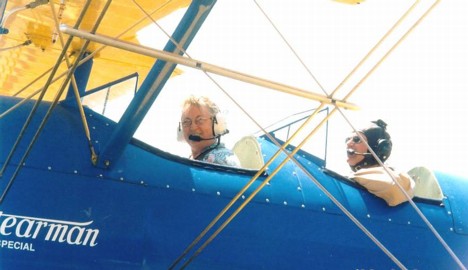 at the Society's July 13 Fly-In. Alex spent several hours taking people for rides in his vintage bi-plane. |
Restoration of the museum's North American Yale has progressed tremendously over the last year. As we mentioned in our Spring newsletter, the rear fuselage had been under restoration in the museum shop over winter. This has been completed except for installation of flare tube opening hardware. What has brought the project along greatly is the airworthy restoration of the front tubular fuselage section by the Society's good friend Marcus Stephenson, owner of Allwood Furniture, Calgary, Alberta. Marcus had this component x-rayed and repaired by an AME friend in Calgary. He then painted it himself and delivered it to the museum! All this at no cost to the Society. Marcus is also restoring his own N.A. Yale to flying condition. The Society has helped him with parts and will help again whenever possible. The Society extends a GRATEFUL THANKS to Marcus Stephenson for his help in making this project viable. The restoration of the Yale with his assistance will be the first airworthy restoration of an aircraft by the NLS museum. The next component that will be restored in the museum shop over winter is the wing centre-section. Again it will be restored to airworthy condition. The team of AME Greg Morrison, volunteer Bob Long, an AME John Philips will be doing the work. The Society is looking for additional components, in particular a Wright 975 engine and a restorable set of wings. The two wings now on hand are not in great shape and would require great effort to restore. If anyone reading this knows where wo might obtain a restorable set of wings and/or other items, please contact the curator at the museum. |
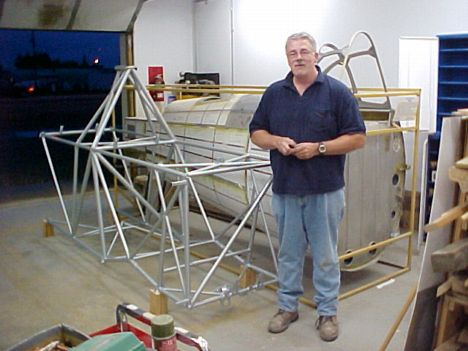 is seen here beside the Yale fuselage frame that he had restored to airworthy status for the museum. Seen in the background is the Yale's rear fuselage in its jig. It has also been restored as airworthy by volunteer AME Greg Morrison, assisted by AME John Philips and volunteer Bob Long. It is nearly ready for painting which Marcus has offered to do! |
Progress is being made in the restoration of "Annie" even though the visitor may not yet see an actual improvement to the airframe exhibited. One upgrade to the fuselage is the temporary installation of the wood formers. In addition to this the floor that will be mounted between the wing centre-section spars is nearing completion. This work is being done by Anson restoration team members Harry Volk and Rob Pedersen. The team lost member Jack Hicks, who has moved back to Regina. Jack's enthusiasm and energy is sorely missed. The Society wishes Jack and his wife all the best in their new home. Presently on display along with "Annie's" fuselage is a Jacobs engine display showing the history of this engine. This display was made up by member Doug Holt, of Coaldale, Alberta. The Society had given Doug a derelict Jacobs L6 engine to restore and mount. This engine will be returned for display along with the other engines in the museum's collection. |
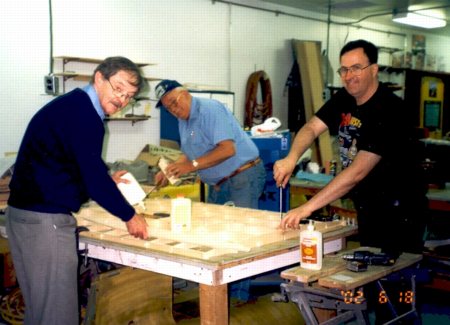 Jack Hicks is working on another project in the background. Jack is no longer with us having moved to Regina, Saskatchewan. |
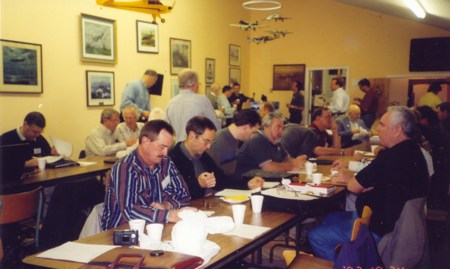 Dan Fox and Dave Birrell in foreground. |
The most successful CAPA conference to date was held October 25 to 27, at the British Columbia Air Museum,
in Sydney, B.C. It was attended by 74 delegates from 26 air museums across Canada. NLS was represented by
president Dan Fox, treasurer Dave Birrell, curator bob Evans, and director Bob Long. Unfortunately plans to fly into Comox, on Thursday to visit the Comox Military Museum, and a bus trip to Sprout Lake to see the Martin Mars water bombers were scrapped due to Comox being fogged in all day. After a five hour delay waiting for weather to clear at Comox the Calgary "WestJet" flight flew directly to Victoria airport with many disappointed delegates. The opportunity to rub shoulders with our contemporaries from other parts of Canada is probably the most beneficial part of these get-togethers. Helping each other with parts, information, etc., has benefited nearly every museum. Also having the conference in a different location each year lets everyone see first hand what other museums are doing. Your Society delegates definitely came home with some new ideas and with a potential trade involving a set of restorable wings for the Yale project. The B.C. Aviation Museum's Anson project was another item of interest. The wing for this is being built in three pieces to facilitate ease of construction. Ideas were gleaned for future displays such as a model which visually demonstrates how a radial engine works. NLS delegates extend a special THANKS to BCAM president Stan Henderson and his group for their hospitality and for hosting a great convention! |
Society volunteer Walter Montgomery, who is 80 years young, almost single-handedly built the kiosk seen in the photo below. In addition to the much needed kiosk he also built and donated the gift shop display walls and racks that can be seen in the background. The Society extends a very grateful THANKS to Walter Montgomery for this great addition to the museum and for his continuing interest! |
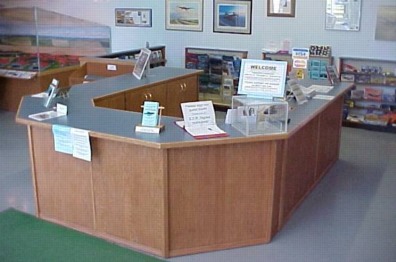 |
In February 2002 through the efforts of member Peter Whitfield the Society purchased a D.R. compass in England. As conventional transportation was cost prohibitive, we contacted our good friend Air Canada Captain Karl Kjarsgaard. Once again Karl agreed to help us out by picking up the compass on his next scheduled flight to London. The compass arrived in Canada via the cockpit of a Boeing 767 after much questioning and explanations at airport security. One of Karl's comments was "not once did we need to use it for navigation!" A grateful THANKS to Karl for delivering the compass and for his continued interest in our efforts. |
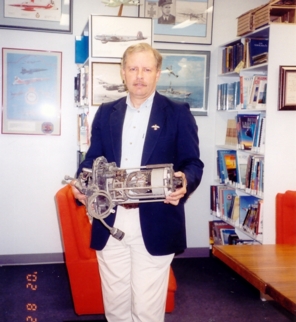 delivering the DR compass purchased in England. |
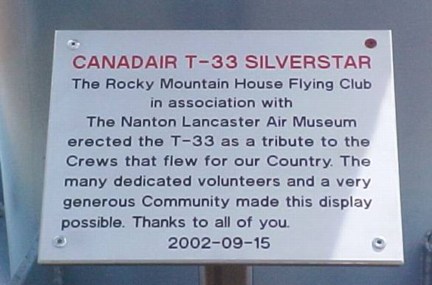 the Rocky group with the T-33 project |
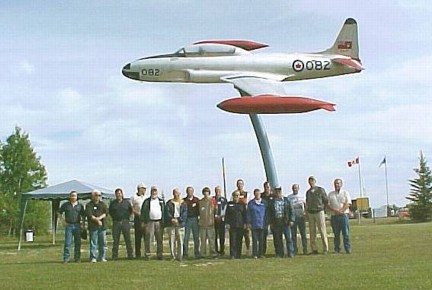 |
